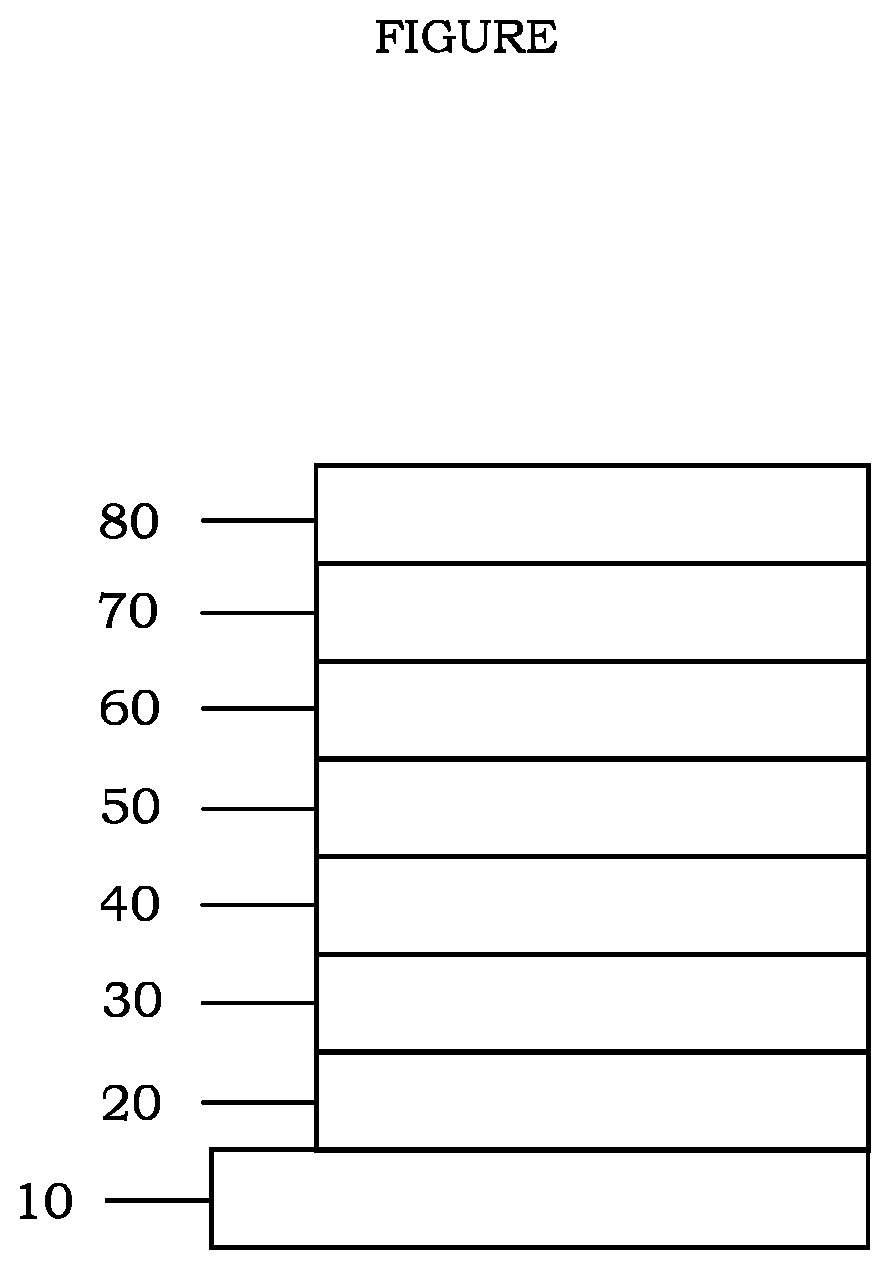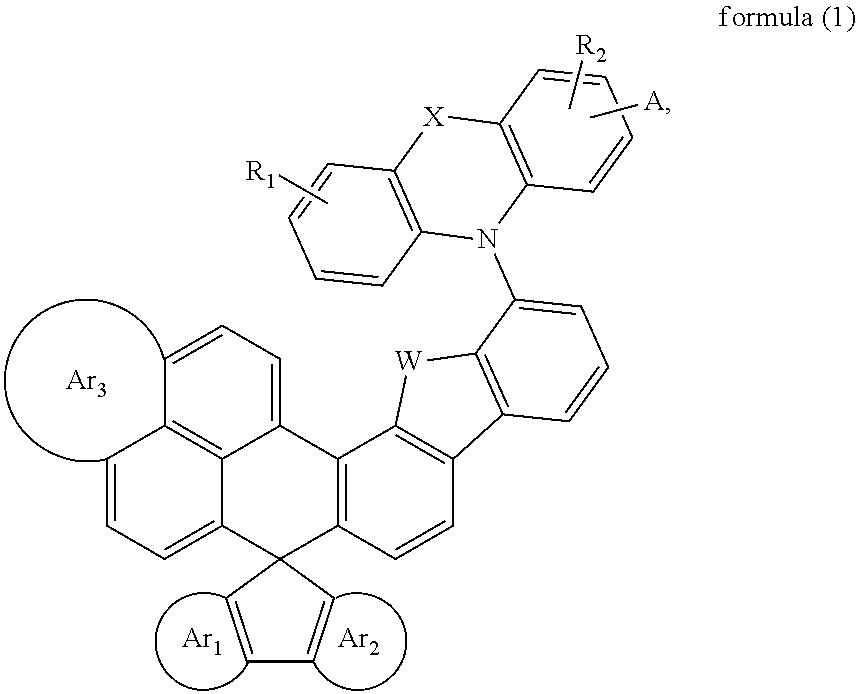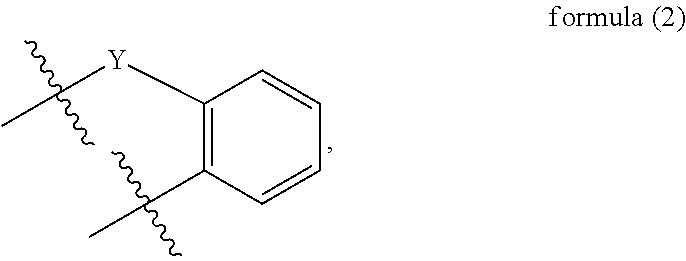Heteroaromatic compound and organic electroluminescence device using the same
a technology of organic el and compound, which is applied in the direction of luminescent compositions, organic chemistry, chemistry apparatus and processes, etc., can solve the problems of driving voltage, current efficiency, and half-life of organic el devices, so as to improve the current efficiency, power consumption, and life time of the device
- Summary
- Abstract
- Description
- Claims
- Application Information
AI Technical Summary
Benefits of technology
Problems solved by technology
Method used
Image
Examples
example 1
Synthesis of Intermediate A
[0021]
[0022]A mixture of 13 g (40 mmol) of 4,6-dibromobenzofuran, 11.3 g (40 mmol) of bis(4-tert-butylphenyl)amine, 0.9 g (0.8 mmol) of Pd2(dba)3, 1.2 g (0.6 mmol) of tri-tert-butylphosphine, 5.0 g (52 mmol) of sodium tert-butoxide, and 150 ml of toluene was placed under nitrogen, and then heated and stirred at 70° C. for 24 hrs. After the reaction finished, the mixture was allowed to cool to room temperature. The solution was extracted with 100 ml of ethyl acetate and 300 ml of water. The organic layer was dried with anhydrous magnesium sulfate and the solvent was evaporated under reduced pressure. The residue was purified by column chromatography on silica to give product (16 g, 30.4 mmol, 76%).
Synthesis of Intermediate B
[0023]
[0024]A mixture of 16 g (30.4 mmol) of Intermediate A and 100 ml of THF was placed under nitrogen and stirred at −78° C. After n-BuLi (2.5 M in hexane, 13.6 mL) was added dropwise, the temperature was raised to 0° C. and the mixtur...
example 2
Synthesis of EX6
[0031]
[0032]The same synthesis procedure as in Synthesis of EX1 was used, except that 0.77 g (4.0 mmol) of Cyclopentadithiophene Ketone was used instead of 9H-fluoren-9-one to obtain 1.2 g (40%) of EX6. MS(m / z, EI+): 772.2.
example 3
Synthesis of methyl 2-((9,9-dimethyl-9H-fluoren-2-yl)amino)-benzoate
[0033]
[0034]A mixture of 10 g (36.6 mmol) of 2-bromo-9,9-dimethyl-9H-fluorene, 6.64 g (43.9 mmol) of methyl 2-aminobenzoate, 0.3 g (1.46 mmol) of Pd(OAc)2, 17.9 g (54.9 mmol) of cesium carbonate, and 120 ml of o-xylene was degassed and placed under nitrogen, and then heated to reflux for 12 hrs. After the reaction finished, the mixture was allowed to cool to room temperature. Subsequently, the solvent was removed under reduced pressure, and the crude product was purified by column chromatography, yielding 10 g of methyl 2-((9,9-dimethyl-9H-fluoren-2-yl)amino)benzoate as yellow oil (79.6%), 1H NMR (CDCl3, 400 MHz): chemical shift (ppm) 8.97 (s, 1H), 8.11 (d, 1H), 7.87 (d, 1H), 7.75-7.64 (m, 3H), 7.41-7.29 (m, 3H), 7.08 (m, 1H), 6.92 (d, 1H), 6.77 (d, 1H), 3.79 (s, 3H), 1.57 (s, 3H), 1.54 (s, 3H).
Synthesis of 2-(2-((9,9-dimethyl-9H-fluoren-2-yl)amino)phenyl)-propan-2-ol
[0035]
[0036]The compound methyl 2-((9,9-dimethyl-...
PUM
| Property | Measurement | Unit |
|---|---|---|
| EQE | aaaaa | aaaaa |
| EQE | aaaaa | aaaaa |
| internal quantum efficiency | aaaaa | aaaaa |
Abstract
Description
Claims
Application Information
 Login to View More
Login to View More - R&D
- Intellectual Property
- Life Sciences
- Materials
- Tech Scout
- Unparalleled Data Quality
- Higher Quality Content
- 60% Fewer Hallucinations
Browse by: Latest US Patents, China's latest patents, Technical Efficacy Thesaurus, Application Domain, Technology Topic, Popular Technical Reports.
© 2025 PatSnap. All rights reserved.Legal|Privacy policy|Modern Slavery Act Transparency Statement|Sitemap|About US| Contact US: help@patsnap.com



